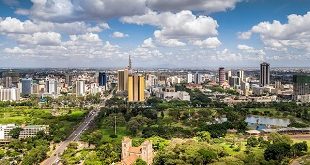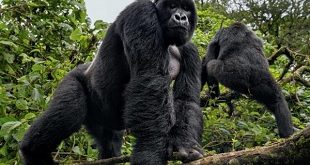
By Obed K. Katureebe
Why does America expect 4,000 AU troops to do what 38,000 UN troops failed to do?
Sometime in late February 1995, 2,400 Pakistani and Bangladeshi peacekeepers made the now famous amphibian retreat from the Somali capital, Mogadishu.

They were the last of 38,000-strong UN peacekeeping force from 21 countries sent in to save Somalia from war and famine in 1992.
As they retreated three years later, there was no peace to keep as Somali warring faction continued to battle for control of Mogadishu.
In fact, to provide cover for the retreating peacekeepers, the United States, Italy, France, Britain and Malaysia assembled a force of 14,000 troops.
The force arrived on 32 ships and camped off the Somalia coast for at least a week before moving in.
The Americans had retreated earlier in 1993, after 18 Americans were killed in fighting with Somali-warlord Gen. Mohamed Farrah Aidid that October, and the body of a dead American soldier was dragged through the streets of Mogadishu.
America turned over the Somalia mission to the UN and emphasis shifted from humanitarian work to reconstruction as a way of helping restore a government in Somalia. That effort failed and the UN also ended its mission.
Somalia has been racked by violence since dictator Mohamed Siad Barre was overthrown in 1991.
Almost two decades later, the government of Uganda forces (UPDF) under the auspices of the African Union has sent in 3,500 peacekeepers. They have been joined by forces from Burundi. Africa’s biggest peacekeeper, Nigeria promised 850 forces but reneged.
Flagging off the Ugandan forces, President Yoweri Museveni sounded realistic.

‘We will not go to Somalia to impose peace on the Somalis, because we shouldn’t do that and we can’t do it,’ President Museveni said to his troops, ‘What we are going to do in Somalia is to empower our Somali brothers to rebuild their state.’
But by mid-this July, reports from Mogadishu were indicating that the AU peacekeepers were floundering in their mission – to defend Mogadishu port, the airport, key government buildings, and Sharif Ahmed, the Somalia president, who is struggling to take control over the Horn of Africa nation from the fighters bent on overthrowing his western-backed government.
Media reports claimed that the Al-Shabaab fighters and other anti-government groups control swathes of southern and central Somalia and have cornered and restricted the AU and government troops in just a few blocks of Mogadishu.
The AU denies it, but Somali government officials and witnesses say the AU has finally relinquished its neutral, defensive mandate and is becoming more offensive.
‘Amisom [the peacekeeping force] backed us up in this latest operation because the rebels were only one kilometre to the presidential palace,’ a Somali official said.
But AMISOM Spokesman, UPDF Maj. Barigye Bahoku denies it. He is quoted by Al Jazeera: ”We have not been engaged [in fighting]. (So) we moved in, we showed force and we went back to the base and the government forces are continuing with their work.’
All these developments raise the question: can Uganda and the AU, do with 3,500 soldiers, what the UN failed to do with 38,000?
Troop numbers matter.

That is why Somali President Sharif has shuttled from Uganda, Sudan, Kenya, Djibouti, and Ethiopia begging for more troops.
The AU pledged 8,000 troops but there are only about 3,500 in Mogadishu. They are too few and too over-stretched.
Initial indications were that no countries were offering any new forces. But that could change soon. America has joined the hunt for more troops for Somalia and has reportedly offered to pay for the deployment.
So Somalia Prime Minister Abdirashid Ali’s claim last week, that troops from Nigeria, Djibouti, Rwanda, Malawi, Sierra Leone and Ghana could enter Mogadishu soon might not be too far-fetched.
Indeed, UPDF Chief of Staff Brig. Robert Rusoke told The Independent on July 14 that AU is reviewing means of sending more troops to Somalia.
‘We have no scheduled time to leave Somalia. We shall leave when we are convinced that there is total peace and a sound government in place,’ said Brig. Rusoke.
But forces opposed to the Somali government are also marshalling more support. The Somali government claims the fighting has been joined by Islamic fundamentalist fighters from Eritrea, Afghanistan, Pakistan, and Yemen.

After a bout of recent fighting, the government showed the body of a fighter it said was an Afghan national fighting with Hizbul Islam, an umbrella opposition group led by Sheikh Hassan Dahir Aweys.
They claimed to have captured other fighters from Pakistan and Yemen.
Highly placed security sources told The independent that Eritrean prisoners of war who are now in the custody of AU forces confessed that they belonged to a big force which was sent by the Eritrean government to assist Al Shabaab to rid Somalia of all foreign forces.

Be that as it may, Brig. Rusoke says the United Nations would soon take over the mandate of the Somalia peace mission. The UN was supposed to take over the AMISOM after six months in operation but it has not.
On July 14, the AU begged for international support for the transitional federal government of Somalia (TFG). AU Special Representative to Somalia Nicolas Bwakira, made the impassioned appeal at the two-day Joint AU, IGAD and UN Political Office for Somalia Technical/Experts Meeting on Capacity Building Support to Somalia in the Kenyan capital, Nairobi. The UPDF Commander of the Land Forces, Lt. Gen. Katumba Wamala, who oversees the Somalia operation, was in Nairobi for this meeting.
Before that, the UN Security Council on July 9 slapped sanctions on the government of Eritrea for her alleged involvement in the Somalia conflict.
Eritrea, which is said to support insurgents in the Ogden region against the government of Ethiopian Prime Minister Meles Zenawi, is allegedly bolstering Al-Shabaab’s firepower and inflicting a heavy price on the AU forces.
On July 11, the UPDF contingent in Mogadishu lost three soldiers during the intensive fighting when the insurgents shelled the presidential palace with mortars. Sources in Mogadishu also said 15 UPDF troops had been critically wounded in the fighting although the Ugandan army spokesman Maj. Felix Kulayigye last week acknowledged only one wounded.
In another incident, an AMISOM source in Mogadishu told The Independent from Mogadishu that a few weeks back, two UPDF soldiers died instantly when insurgents lobbed a grenade into their vehicle at Shakala detach, injuring 13 others.
As if to show that they rule Mogadishu, the Al Shabaab showed mode of justice when they held a ceremony in the capital, in which they chopped off a hand and foot from each of four men convicted of stealing mobile phones and other items.
They are said to be just 2 kilometers from capturing the Presidential Villa.
Enter America

That is why a ceremony held at the Kasenyi military training school in Entebbe on June 16 is significant.
At the ceremony, 134 UPDF soldiers completed the sixth military-to-military counter terrorism course conducted by the United States of America Combined Joint Task Force – Horn of Africa (CJTF-HOA).
‘This training is an excellent example of how Uganda and the United States government work together to promote peace and stability,’ said US Army Colonel Matthew Grays, CJTF-HOA joint civil-military operations director.
The US has been training the Ugandan army for years and although his star may be fading, President Museveni has for years been an important US ally.
As a result, Uganda has thrived on American aid. In return, Uganda has provided America with critical military support, especially intelligence on the Great Lakes region.
Museveni’s latest assignment on behalf of America might be to provide more boots on the ground in Somalia. The Kasenyi ceremony is important because those UPDF graduates could be headed to Somalia.
Already, as the Washington Post and the Voice of America reported on June 27, the US government had in the previous six weeks provided about 40 tons of weapons and ammunition to shore up the besieged government of Somalia and has sent funding to train Somali soldiers.
The report was attributed to a senior State Department official who briefed reporters on the condition of anonymity and said the military aid, worth about $10 million (approx. Shs 20 billion), had been approved by Secretary of State Hillary Rodham Clinton and the US National Security Council.
‘We do not want to see Somalia become a safe haven for foreign terrorists,’ the official said.

The story said the US government has asked the UPDF to give Somali soldiers small arms and ammunition. The US government is then resupplying the Uganda.
The US government will also help pay for the Kenyan, Burundi and Ugandan militaries to train Somali soldiers, and is providing logistical support for the AU troops.
It added that Clinton calls Somalia’s president to consult on the crisis.
Such high profile intervention by the US has renewed speculation about motives beyond merely humanitarian.
The Somalia fighting has killed 250 civilians and forced more than 160,000 people to flee their homes in June alone.
Internally Displaced Persons (IDPs) in Somalia are estimated at over one million in a country of eight million. They lack food, emergency relief supplies, and essential health, shelter, and water, sanitation and hygiene services.
The US has been a leading donor of humanitarian assistance to Somalia, with more than US$156 million in FY 2006 – 2007, and US$74 million in FY 2008.
Somalia oil
However, a statement attributed to the Association of American Petroleum Geologists claims that based on published and unpublished data, the geology of Somalia, ‘proves that oil and gas have been generated with favorable reservoirs, as well as structural and stratigraphic traps. Moreover, continuation of these basins across the gulf, matching the hydrocarbon-producing Marib-Hajar and Say’un-Al Masila basins of Yemen, raises the hydrocarbon prospect of northern Somalia.’
A 1993 story in the Los Angeles Times claimed that four major US oil companies; Conoco, Amoco, Chevron and Phillips, had been allocated nearly two-thirds of Somalia in the final years before Somalia’s pro-US President Mohamed Siad Barre was overthrown and the nation plunged into chaos in January, 1991.
Significantly, when the US government in February 2007 announced a presidential directive to establish a unified combatant command called African Command (AFRICOM), analysts immediately zeroed on the growing interest in protecting for itself the newly found Africa oil and gas fields as the motive.
War on Terror
But America also worries about Somalia breeding the next Al-Qaeda terrorists.
At the height of the early 2009 attacks on ships by Somali pirates, a story in the Washington Post reported that defense officials had recommended pre-emptive strikes against Al Shabaab training camps ‘based on the potential threat the group poses to American interests.’
At the time, US Defense Secretary Robert Gates suggested to ‘improve governance and economic stability’.
Before AFRICOM in 2002, CENTCOM’s Combined Joint Task Force Horn of Africa (CJTF-HOA) began establishing a permanent 1,500 troops forward operating base at Camp Lemonier, an old French Foreign Legion base in Djibouti, using the pretext of the War on Terror.
Its mission is to detect, disrupt, raid, and defeat transnational Al-Qaeda groups suspected to be operating in the region, especially in Somalia.
Such bases give the US strategic control of the maritime zone through which a quarter of the world’s oil production passes and is in proximity to the Sudanese oil pipeline.
In addition to Djibouti, there are prominent forward-operating bases located in Kenya, Ethiopia (two of the nations identified as regional anchors in the NSS), and Uganda, geographically situated near both the southern edge of Sudan (the part where most of the oil is) and the resource-rich, highly-prized Great Lakes region.
Great expectations
Analysts say that although, Ethiopia’s Zenawi and President Museveni have accepted top be America’s footmen in Somalia, they need to pay attention to a December 2006 Report to Members of the US Committee on Foreign Relations that read: ‘One Central African country in particular illustrates the need for State Department perspective and guidance to temper Defense Department enthusiasm. The country is unstable, desperately poor, and run by a repressive government that is being challenged by a persistent armed resistance. Desperate for a military strong enough to protect it from the rebels, the government has signed an Article 98 agreement, exempting US military personnel from International Criminal Court procedures and thus enabling it to receive military assistance. It has also signed a Status of Forces Agreement (SOFA) with the United States. With extensive ‘under-governed spaces’ as potential terrorist havens and bordering countries with equally uncertain futures, the country was termed ‘a model country for security assistance’ by the regional combatant command. Civilian embassy officials, however, are demonstrably less keen. They question the rate at which military programs are rapidly escalating and the sizable and still growing presence of U.S. military personnel in-country. A US-labeled backpack, observed on a government soldier undergoing US training, underscored for SFRC staff the potential complications of a too-close association with the country’s military. It would be a major setback if the United States were to be implicated in support of operations shoring up the repressive regime, regardless of the stated intent of such training.
The ‘central African country’ was not named. It could be Ethiopia or Uganda.
 The Independent Uganda: You get the Truth we Pay the Price
The Independent Uganda: You get the Truth we Pay the Price



